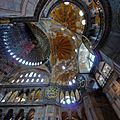Semi-dome facts for kids

A semi-dome(also called a "half-dome") is the term in architecture for half a dome. It is used to cover a semi-circular area, usually an apse. A semi-dome was often used at each end of a barrel vaulted ceiling.
History
An early use was to cover Roman cult images. They are a feature found in Ancient Roman and traditional church architecture. The semi-dome is featured in Byzantine architecture and Early Christian architecture. They are prominent in mosques and iwans in Islamic architecture. Some mosques featured semi-domes decorated with glass mosaics. In the second half of the 6th century Ottoman architecture began using half-domes combined with domes. Semi-domes were common in Roman baths, palaces and large buildings. During the Dark Ages in Britain whenever an apse was built, a semi-dome covered it. In 11th century Normandy every apse of every church had a semi-dome over it. The semi-dome went out of use when the east end of churches were squared.
Images for kids
-
Looking up at the radiating semi-domes of Hagia Sophia
-
Exterior of the Sultan Ahmed Mosque
-
Interior of Sultan Ahmed Mosque ("Blue Mosque"), İstanbul. The main dome is surrounded by four semi-domes, three of which are visible in this image. They in turn have smaller semi-domes hanging off them.
-
Painted semi-dome; Parma Cathedral
-
Tribune with semi-dome, Winter Palace
See also
 In Spanish: Bóveda de horno para niños
In Spanish: Bóveda de horno para niños











